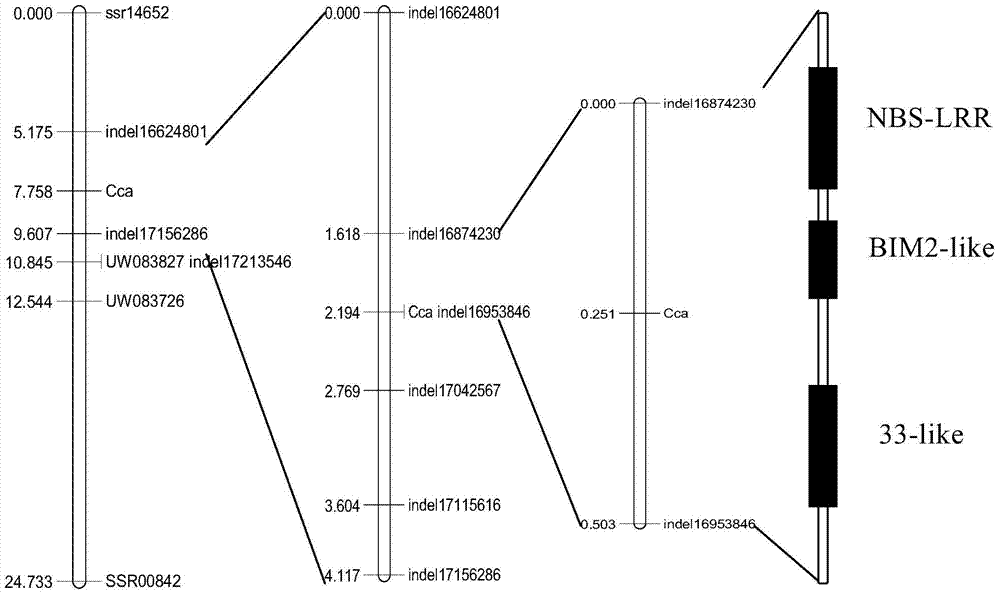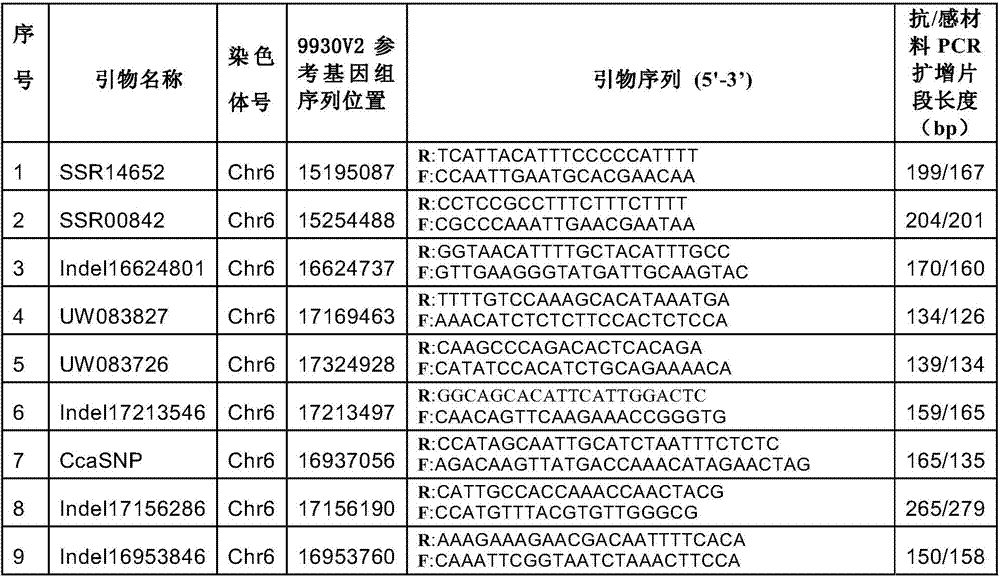Cucumber target spot disease resistance gene cca and its encoded protein and application
A cucumber target spot disease and disease-resistant gene technology, applied in the field of gene sequence and application, to achieve the effect of improving breeding efficiency
- Summary
- Abstract
- Description
- Claims
- Application Information
AI Technical Summary
Problems solved by technology
Method used
Image
Examples
Embodiment 1
[0029] Example 1: Acquisition of Cucumber Target Spot Disease Resistance Gene Cca
[0030] 1. Preliminary and fine mapping of cucumber target spot disease resistance gene Cca
[0031] The specific positioning method includes the following steps:
[0032] A. Mapping research on resistance genes of cucumber target spot disease Parents and genetic groups:
[0033] Select WF2757 (female parent) and Xintaimici (male parent) as resistant parents, and construct 150 strains of F 2:3 populations and more than 2000 strains of F 2 large groups. Among them, the male parent Xintaimici and the female parent WF2757 were purchased from the Beijing Crop Germplasm Bank.
[0034] B. Investigation of Disease Index of Cucumber Target Spot Disease Resistance Gene Mapping Research:
[0035] The seeds of parents and each group were wrapped with gauze, soaked in warm soup, and then sowed in 50-hole hole trays after germination at a constant temperature of 28°C. Seedlings were raised in an air-condi...
Embodiment 2
[0059] Example 2: Identification and Analysis of Cucumber Target Spot Disease Resistance Gene Cca cDNA and Protein Sequence
[0060] 1. The cDNA (mRNA) full-length amplification of the target spot disease gene Cca of cucumber wilt:
[0061] Using the resistant and susceptible parental materials WF2757 and Xintaimici, young leaf tissues were selected to extract total RNA, and reverse transcription was performed to synthesize the first strand of mRNA (cDNA). Using the first strand of mRNA as a template, the full-length Cca gene was used Amplify the upstream and downstream primers SEQ ID NO: 7 and SEQ ID NO: 8 for PCR amplification to obtain the full-length cDNA (mRNA) sequences SEQ ID NO: 3 and SEQ ID NO: 4 in the anti- / sensitivity material, respectively. Using DNAMAN software to compare and analyze the full length of the Cca gene in the resistant / susceptible materials, it was found that the gene has only one exon and no intron structure in the resistant / susceptible materials, b...
Embodiment 3
[0068] Example 3: Functional verification of disease-resistant gene Cca and its application in breeding cucumber target spot disease-resistant varieties
[0069] 1. Functional verification of cucumber target spot disease resistance gene Cca
[0070] 1. Materials to be tested: use WF2757 and GY14 as parents to construct F 2 Genetic population, from which 120 individual plants were randomly selected for target spot disease resistance identification and sequencing. Among them, the male parent GY14 and the female parent WF2757 were purchased from the Beijing Crop Germplasm Bank.
[0071] 2. Wrap the seeds of the above-mentioned materials to be tested with gauze, soak them in warm water, sow them in 50-hole trays after accelerating germination at a constant temperature of 28°C, and raise seedlings in an air-conditioned greenhouse. Extract the genomic DNA of each material to be tested from the seedlings, and use each genomic DNA as a template to perform full-length PCR amplificati...
PUM
 Login to View More
Login to View More Abstract
Description
Claims
Application Information
 Login to View More
Login to View More - R&D
- Intellectual Property
- Life Sciences
- Materials
- Tech Scout
- Unparalleled Data Quality
- Higher Quality Content
- 60% Fewer Hallucinations
Browse by: Latest US Patents, China's latest patents, Technical Efficacy Thesaurus, Application Domain, Technology Topic, Popular Technical Reports.
© 2025 PatSnap. All rights reserved.Legal|Privacy policy|Modern Slavery Act Transparency Statement|Sitemap|About US| Contact US: help@patsnap.com



